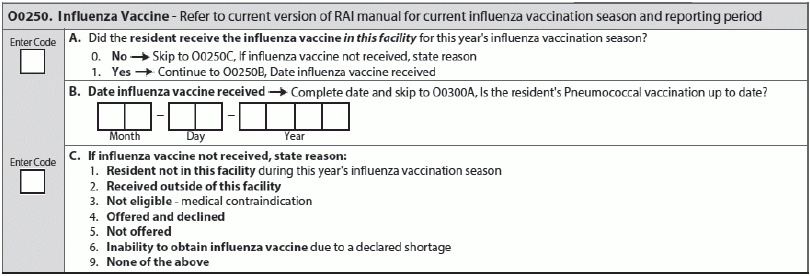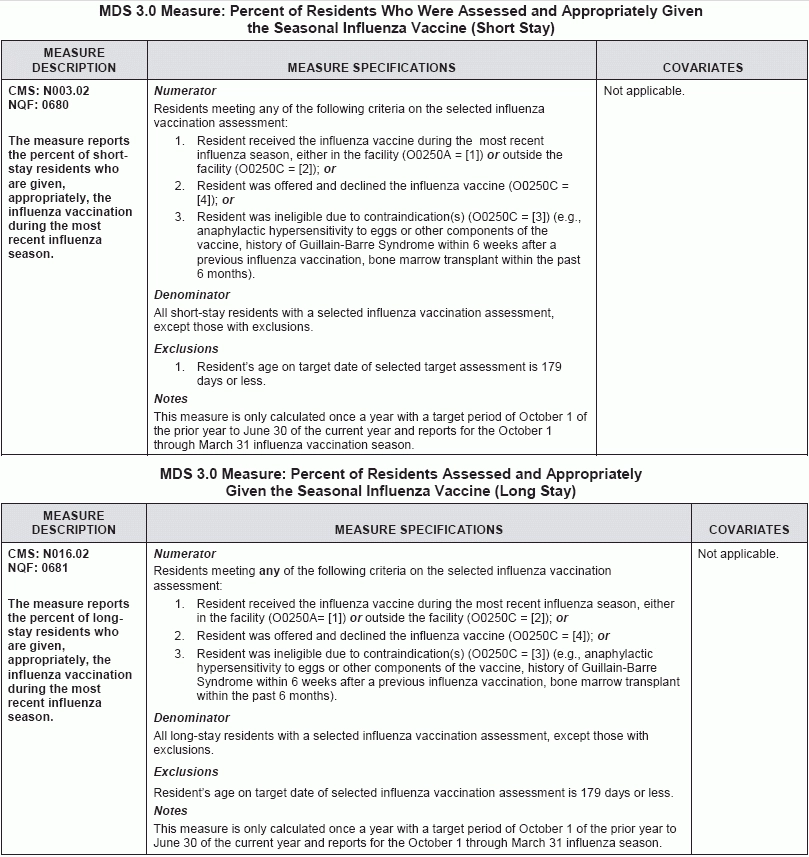Watch Your O0250 Coding To Protect Your Flu Vaccine QM Scores
Learn which responses will cause your score to take a nosedive.
If you’re coding the flu vaccine incorrectly on the MDS, you’re likely sinking your score for several important quality measures (QMs). You need to pay attention to any resident records with certain responses in Item O0250 — Influenza Vaccine, and be sure to correct any mistakes in your MDS coding before your QM score is calculated this summer.
Know the 4 Flu Vaccine QMs
The Centers for Medicare & Medicaid Services (CMS) has several short- and long-stay QMs relating to influenza vaccination, which pull data from your coding of Item O0250. These QMs include:
For the “Percent of Residents Who Were Assessed and Appropriately Given the Seasonal Influenza Vaccine” specifically, a higher percentage is better, according to a Feb. 2 tutorial by Washington, D.C.-based Leading Age.
Are You Choosing the Correct Responses?
The answer choices for O0250A — Did the resident receive the influenza vaccine in this facility for this year’s influenza vaccination season? are simply 0 — No or 1 — Yes. “While entering a dash [-] is technically allowed, there is no clinical reason to code O0250A with a dash, because every community should be able to determine whether or not the flu vaccine was administered in this facility for this year’s flu season,” Leading Age noted.
But if you enter 0 — No for O0250A (indicating that the resident did not receive the flu vaccine this season), you’ll then need to answer O0250C — If influenza vaccine not received, state reason. For this sub-item, you must choose from seven possible responses:
How to Do the Math
To calculate the QM, “Percent of Residents Who Were Assessed and Appropriately Given the Seasonal Influenza Vaccine,” the numerator includes residents coded with the following on the selected influenza vaccine assessment:
The denominator includes all residents (short-stay or long-stay, respectively) with a selected influenza vaccine assessment, except those with the exclusion of “resident’s age on target date of selected influenza vaccination assessment is 179 days or less.”
Mistake: “One common misconception is that certain answers are excluded from this measure,” Leading Age stated. But in fact, “no answers to any questions in O0250, including the dash, are excluded.”
Based on the QM’s calculation methodology, a good indication that you’ll get a high score is if nearly all of your residents are coded as received the flu vaccine either in or outside the facility, were offered and declined the vaccine, or were ineligible to receive the vaccine due to contraindication.
Red flags: This means that you should pay close attention to any resident’s MDS coded in O0250C as 5 — Not offered, 6 — Inability to obtain influenza vaccine due to a declared shortage, or 9 — None of the above. These “will go in the denominator, driving the percentage down,” Leading Age cautioned.
Notice that the QM doesn’t forgive an inability to obtain the flu vaccine, even for a declared shortage.
Know the Data Timeframes
Remember: You are coding O0250A for the current flu season, which began in Fall 2015 and is ongoing at present, Leading Age said. “If the resident remains in the community after flu season and an MDS is due, the answer that applies to the current flu season remains constant for each subsequent MDS until an Assessment Reference Date (ARD) that falls within the influenza vaccination season for Fall 2016 through Spring 2017.”
For the current flu season, CMS will calculate the QM at the end of June 2016 for all residents who were in your community between Oct. 1, 2015 and March 31, 2016, Leading Age stated. Once calculated, the QM percentage “will remain constant until it is recalculated at the end of June 2017.”
Problem: But monitoring how each resident is coded for the flu vaccine is a challenge because none of the vaccine measures are on your CASPER reports, Leading Age warned. Instead, you must use your internal software reports or manual accountability to double-check the coding for the flu vaccine short- and long-stay QMs.
Bottom line: That’s why you need to verify accurate MDS coding now — so you can make the necessary corrections before the June calculation for 2016.



